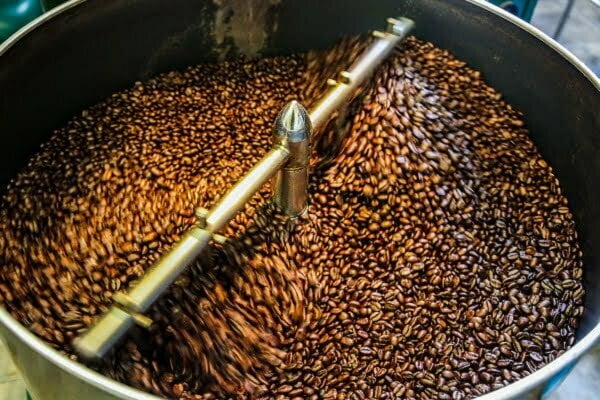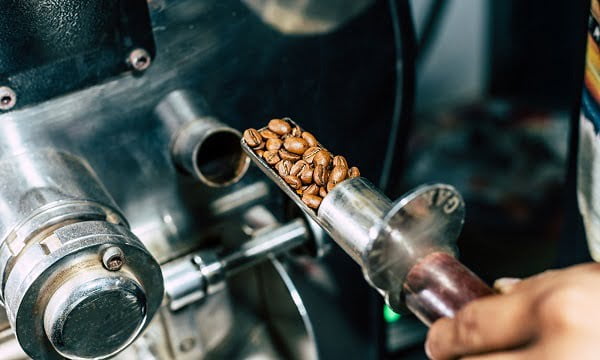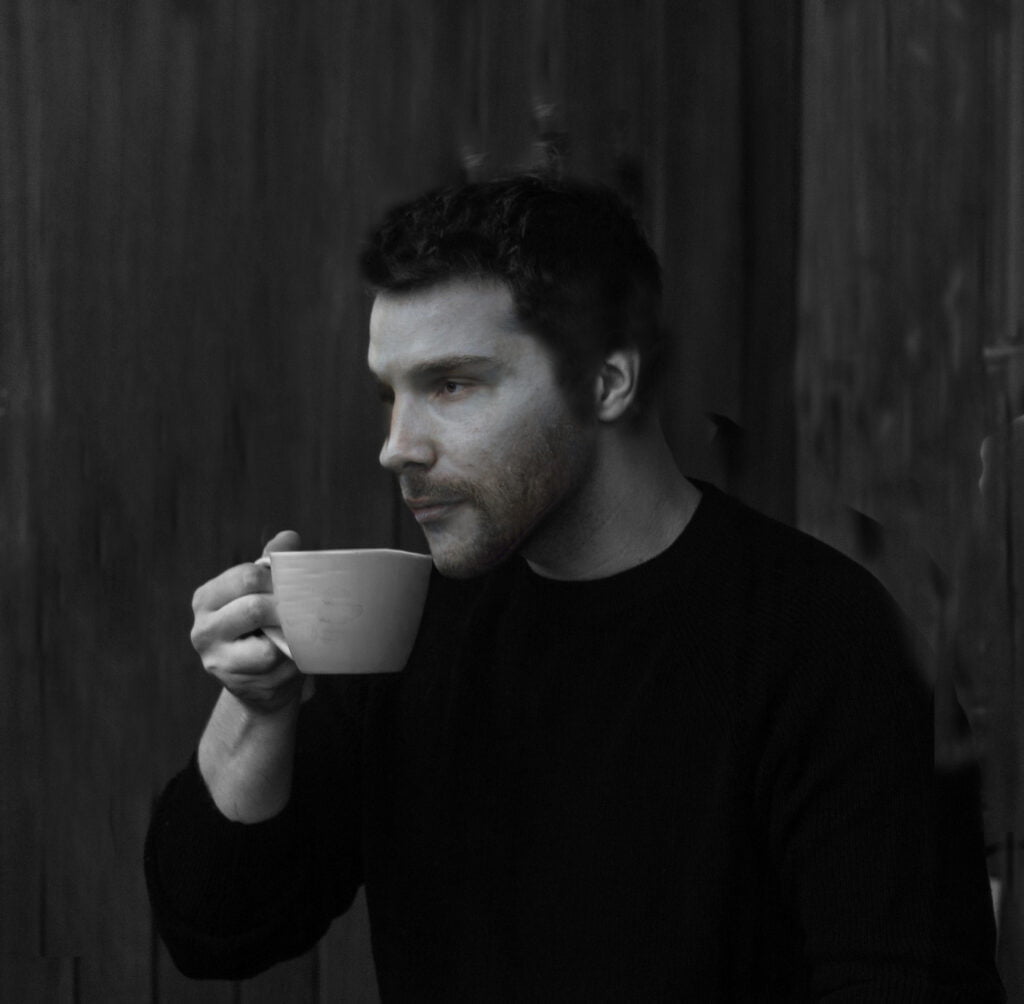You can’t just brew raw green coffee and expect it to taste good. It needs to be roasted first to unlock all the delicious flavors that make it so magical.
Coffee beans begin as seeds inside a coffee cherry. The cherry is processed, dried, and then usually shipped before being roasted to create the coffee beans that we know and love.
If you were to try and make coffee with unroasted coffee you first of all would really struggle to grind the beans and secondly, if you did manage to, you’d end up with a very bitter-tasting plantlike green coffee.

What is a Coffee Roaster?
Well, in fact, a coffee roaster today can mean a couple of different things.
First of all a coffee roaster is a specialized machine or device designed to roast green coffee beans.
Roasting is a complex process that involves careful control of temperature, time, and airflow to develop the desired flavors and aromas within the beans.
The process of roasting takes the raw, green coffee beans and turns them into the brown, flavorful beans we recognize as coffee.
Secondly, a coffee roaster can actually refer to the business or the person who roasts the coffee, for example, Foundation coffee roasters is an independent coffee roasting business in the UK that roasts green coffee beans.

How do Coffee Roasters Work?
Coffee roasters (as in the machines) come in different types, but they all operate on the basic principle of applying heat to transform green coffee beans into roasted coffee beans with their characteristic flavors and aromas.
Drum roasters, the most common type, use a rotating drum to agitate the beans. This ensures even heating and consistent flavor development.
Fluid bed roasters, on the other hand, use hot air to suspend the beans, promoting even roasting through convection.
What is the Coffee Roasting Process?
The coffee roasting process can be divided into three main stages:
- Drying
- Browning
- Development.
During the drying phase, the moisture within the beans evaporates, causing them to swell and change color.
In the browning stage, the beans undergo caramelization and Maillard reactions, which give rise to the complex flavors and aromas associated with coffee.
The development phase is when the final flavor profile is achieved, and the roaster must carefully monitor the roast to avoid under- or over-roasting.
What Factors Affect The Coffee Roast?
Several factors influence the outcome of the roasting process, including time, temperature, bean origin, altitude, and the chosen roasting profile.
Roasters carefully adjust these variables to create specific flavor profiles that bring out the best in each batch of beans.
The origin of the beans plays a significant role in determining how they respond to different roasting conditions, making every roast a unique experience.
Read more about the 4 types of coffee roasts
The Art and Science of Coffee Roasting
Coffee roasting is a delicate balance between art and science.
Roasters must have a deep understanding of the chemistry and physics behind the roasting process, as well as finely tuned sensory skills to identify the subtle changes in flavor and aroma.
It’s a blend of technical expertise in temperature control and timing, combined with an artistic approach to crafting a unique coffee experience that has become synonymous with independent coffee shops.

Types of Coffee Roasts
Coffee beans are roasted to various levels, each producing distinct flavors and characteristics.
Light roasts are roasted for a shorter time and sometimes at lower temperatures, preserving the bean’s natural acidity and floral notes.
Medium roasts strike a balance between flavor development and acidity, while dark roasts feature bold flavors and a rich body due to extended roasting times and higher temperatures.
Read a guide on Light vs dark roast coffee
Importance of Coffee Roasting
The coffee roasting process has a profound impact on the quality of the coffee we enjoy.
A skilled coffee roaster can highlight the inherent qualities of a coffee bean while minimizing defects or undesirable flavors.
Roasting allows the roaster to shape the final flavor profile, ensuring that the coffee is consistent in taste and aroma, and aligns with the preferences of the consumer.
Can you Roast Coffee at Home?
Roasting coffee at home can be done in several ways.
Firstly it is possible to purchase home coffee roasters, these come in various shapes and sizes, some look similar to a microwave with a revolving drum inside, and some like the Ikawa can fit on your kitchen counter and are controlled by an app whereas others are essentially a frying pan with a lid that roasts coffee on your stove.
The sky’s the limit with how much money you want to spend and how much time you want to spend roasting coffee at home and every home roaster has varying levels of quality.
Another way that you can roast coffee at home is in a popcorn machine, although manufactured to heat popping corn, it also doubles as a coffee roaster. This should be taken with a pinch of salt though as the results are questionable.
Thirdly and actually the method that I would first opt for, is roasting coffee on the hob or over a flame in a skillet pan.
The results are by no means perfect as there are many factors and variables in roasting coffee that cannot be controlled in a frying pan. However, this process is perfect for beginners to understand coffee roasting and see the various stages (first and second crack) before investing in a home roasting machine.
Alternatively, if you have a coffee roasting itch that needs scratching (or scratch that needs itching) then pop down to your local coffee roaster and see if they’ll let you see how the magic happens. Most indy roasters are a lovely bunch and usually more than willing to let you see how everything works.
Final Thoughts
Coffee roasting is an artful science that transforms green coffee beans into the aromatic and flavorful beans we grind and brew.
Through controlled heat application and a deep understanding of the roasting process, skilled coffee roasters create a diverse array of coffee profiles that cater to a wide range of tastes.
The coffee roaster is an essential tool in the coffee industry, playing a vital role in delivering the delightful cup of coffee that many of us savor daily.
Read a Guide on Roasting Coffee Beans at Home
FAQs
Where Can I Buy a Coffee Roaster?
If you want to buy a commercial coffee roaster you should contact the manufacturer or various distributors.
As commercial coffee roasters are pretty large machinery and require heavy elements it’s best to consult the manufacturer first.
Coffee roasters are also pretty hardy and you can find roasters that have been operating for decades, so the used coffee roaster market is also a great place to look.
If you alternatively want to purchase a home coffee roaster, take a look at Ikawa or Behmor.
Is Training Required to Operate a Coffee Roaster?
If you are operating a commercial coffee roaster then you will need some training. There are many things that you have to control when roasting coffee if you want to produce the best possible-tasting coffee.
What are the Environmental Impacts of Coffee Roasting?
Coffee roasting, especially gas-powered coffee roasters are obviously not ideal for the environment. There are many new electric coffee roasters on the market today such as Loring that cuts the carbon footprint significantly.



